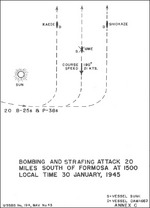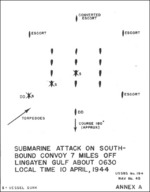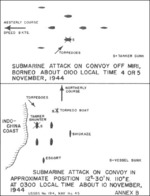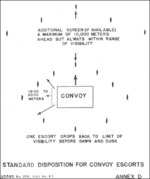Interrogation Nav 45, Lieutenant Commander Shisei Yasumoto
Editor's Note: The following content is a transcription of a period document or a collection of period statistics. It may be incomplete, inaccurate, or biased. The reader may not wish to take the content as factual.
28 Oct 1945ww2dbaseBiography
YASUMOTO, Shisei, Lieutenant Commander, I.J.N.
YASUMOTO, a regular naval officer of 7 years service, gained all his war time sea experience in convoy escort duties as Commanding Officer of the escort vessel Shiokaze and as a Staff Officer, 103rd Escort Squadron of the Seventh Fleet. His personal experiences included several attacks by U.S. submarines and one attack by U.S. Army aircraft. He remembered in detail the circumstances of the various attacks and was particularly impressed by the manner in which our submarines operated offensively in restricted waters. His escort experience extended over the SOUTH CHINA SEA and in the waters near JAPAN during the latter part of the war.
| Commanding Officer, Shiokaze (escort vessel) | March 1944-May 1945 |
| Staff Officer, 103rd Escort Squadron (TSUSHIMA Straits) [sic, should be "TSUSHIMA Strait", ie. in singular form] | |
Interrogation
INTERROGATION NAV NO. 45
USSBS NO. 194
ESCORT AND PROTECTION OF SHIPPING
TOKYO
28 OCTOBER 1945
Interrogation of: Lieut. Comdr. YASUMOTO, Shisei, IJN; Commander of the escort vessel Shiokaze, March 1944 to June 1945; Staff Officer of 103rd Convoy Escort Squadron, Seventh Fleet, from June 1945 to end of war.
Interrogated by: Captain Steadman Teller, USN.
Allied Officers Present: Brigadier General G. Gardner, USA.
SUMMARY
Submarine attacks on Japanese Shipping in the SOUTH CHINA SEA and adjacent waters became increasingly severe during early 1944 and brought about more strict convoy escort instructions and some uniformity of escort formations. However, the lack of escort vessels and the ability of American submarines to attack convoys in very restricted waters where escort formations could not be maintained, partially nullified these efforts to save the rapidly shrinking Japanese Merchant Marine.
Carrier air strikes on shipping in MANILA and CORON Bays in September 1944 disrupted the regularly traveled North-South shipping route which coasted the Western PHILIPPINES prior to that time. Other forms of air attack were of secondary importance until the last month or two of the war, when aircraft mining, low-level attacks by B-25s, and harassing attacks by day and night search planes contributed materially to the final destruction of Japanese shipping.
TRANSCRIPT
Q. Describe the attacks made on convoys while under escort of your ship.
A. While captain of the Shiokaze, our convoys received one air attack and five submarine attacks. The air attack was delivered 30 miles west of BAKO in the PESCADORES, in November 1944 about midnight by one plane (probably a B-24). There was no hit and the closest bomb was 200 meters off from the Teiritsu, a captured French vessel of 8,000 tons. The first submarine attack occurred about 0630 on 10 April 1944, about 7 miles off LINGAYEN Gulf. The convoy was southbound and in following formation. Apparently one submarine succeeded in sinking one destroyer and two of the convoy at a range of about 1500 meters, with three torpedoes apparently fired on the first attack. It is my opinion that six torpedoes were fired of which three sank one ship each, in the following order: destroyer, Army supply ship and an ammunition ship. This was the first casualty which I experienced since a new set of convoy plans and formations had been set up early in March 1944 to meet the increasing difficulty of supply.
The second submarine attack occurred in the middle of June while enroute to MIRI. The convoy was passing very near the southern end of PALAWAN Island on the east side. The time was about 0700. There was a reef to starboard which made it necessary to string the convoy out in column with the escorting vessels close aboard to starboard. In this attack there were no hits, the first of the torpedoes having been very clearly visable because of erratic behavior in the water. The convoy turned into the attack and avoided being hit by any of the others.
The third attack occurred in late June as I was convoying oil tankers north along the West Coast of BORNEO. We received a midnight submarine attack off JESSELTON. Again the convoy was strung out in line because of a narrow inside passage and I was confident that the narrowness of the inside passage would prevent any possible danger of attack. The channel was very narrow but the attack appeared to come from the inshore side and three of the convoy were sunk during a very heavy squall about midnight. This was the first convoy to receive damage in that inward passage off JESSELTON. One tanker and two bauxite cargoes were sunk. The bauxite ships were ships of 5,500 tons, the Hiyori and Hikane. The tanker was 7,000 tons, it may have been Kokusei Maru.
Early in September 1944, I came out from MOJI to MANILA and succeeded in reaching MANILA all right in mid-September. I left MANILA just before the carrier plane attack and took my convoy to BATIKEO Bay in the northern end of PALAWAN. I spent about 20 days vacillating between that bay and ULUGUAN Bay, half-way down PALAWAN, because of the bad conditions in MANILA Bay and CORON which were under attack. In BATIKEO Bay there were many ships, some bound for the EMPIRE and some for the south. About the 1st of October I led my convoy south to MIRI, dropped some Army personnel at JESSELTON. While at JESSELTON, the LEYTE SEA Battle occurred. We took on oil at MIRI. The original plan had been to return the convoy to the EMPIRE by way of MANILA, but owing to the disastrous conditions in the PHILIPPINES, plans were changed and with a convoy of oilers escorted by one destroyer, one torpedo boat and one 150 ton submarine chaser, we went to Cape SAN JACQUES.
We left MIRI on the 3rd or 4th of November in the evening and at 0100 the next morning received a torpedo attack. This attack was delivered from an unknown range to port, and one ship of the convoy on the port side of the formation was sunk.
We left SAN JACQUES, hugging the coast in single line formation. At approximate latitude 12°- 30°N, longitude 110°E, we received a submarine attack at three in the morning about the 10th of November, during a heavy squall. One ship, the tanker Shunten and one torpedo boat were sunk. This attack appeared to come from the inshore side.
Q. Did you experience any air attack in water near FORMOSA?
A. The Shiokaze had a separate duty during January 1945 which was to carry Army and Navy aircraft pilots from APARRI to TAKAO in FORMOSA. The Ume was the flagship, the other two ships were the Kaide and the Shiokaze. We left TAKAO 30 January at 0700. An hour after leaving TAKAO we saw formation of B-24s which was proceeding to the attack of TAKAO, and although we were not then attacked, we considered that we had been discovered and therefore altered course to west rather than making straight south for APARRI. After three hours on the western course, we assumed a course direct for APARRI. At 1500 when 20 miles off the southern tip of FORMOSA, about 20 B-25s and P-38s attacked the three destroyers which were proceeding at 21 knots in a triangle formation. According to plan, ten planes from FORMOSA were to convoy us from the southern tip of FORMOSA south, and we therefore thought that the first few planes we saw at 10,000 meters were our own planes of the GINGA Type. It was only when they circled around ahead of our formation and made an attack did we realize it was B-25s making an attack from the sun. The plane formation divided into three groups, attacking one ship each. The Ume received about four bombs delivered at low level (30 meters). The Kaike received about three. The Ume sank, her stern broke off. The Kaike was damaged about the bridge and was able to return to TAKAO. The Shiokaze received no hits and was able to pick up survivors from the Ume, and take them to TAKAO. The Shiokaze received no direct hits but was so shaken up by near misses that her shafts were shaken out of line and one of her turbines was put out of action. Personnel on the bridge of the flagship (Ume) were nearly all killed by strafing.
Q. To what extent was shipping to and from TAKAO interfered with by air attacks?
A. It wasn't very much in formation or convoys, single ships were frequently hit.
Q. You spoke of a change in convoy plans and instructions in early March 1944. What were significant changes and why were they made?
A. The submarine attacks had been clearly increasing during January and February, particularly in the FORMOSA-PHILIPPINES Area, and until early in March no precision had been exacted with regard to convoy formations. There was a great variety of opinion with regard to convoy formations, particularly the position of the convoy commander's ship. Plans heretofore had been formulated by individual convoy commanders and because many of the coast defense ship captains were reserves from the Merchant Marine, indoctrination was considered necessary, and from the indoctrination plans came some uniformity.
Q. Sketch a diagram of what you considered to be the best protective formation?
A. At this time the Number One Coastal Convoy Unit issued a book of instructions called "Number One Coastal Escort Unit Operating Plans". There are a great many formations, more then ten formations according to the number of ships. When looking out for submarine torpedoes, the normal formation was a block protected by ring formation -- the escort vessels standing off, one thousand or two thousand meters. If there were plenty of escort vessels a screen was sent forward but this situation seldom obtained. This screen was placed about 10,000 meters forward but always within visibility. Well before dawn it was advised that one escort vessel drop back to the limit of visibility and the same procedure at dusk. There was not any settled formation policy as defense against air attacks, but with regard to my own performance during air attacks I ordered the convoy to close formation in order to consolidate anti-aircraft fire.
Q. Under what conditions did convoys zig-zag?
A. Wherever there was room zig-zagging was normal procedure.
Q. What were the special instruction regarding taking shelter at night or taking particular routes to avoid submarine attacks?
A. Beginning about September 1944 special orders were issued for the coast of INDO-CHINA and the PALAWAN Passage to travel only by day and hide during the night. These orders also covered the waters between MANILA and APARRI and the chain of FORMOSA. From August 1944 our casualties had been especially high in area MANILA to FORMOSA.
Q. To what extent did the convoys escorting through the PHILIPPINES receive air assistance?
A. One escorting plane from MANILA used to come in the morning and met convoys going south off LINGAYEN Gulf and stay with them until they entered MANILA. There was another single plane for convoy searches north and west of APARRI; also a single plane per convoy escorted along the coast of INDO-CHINA and the northwest coast of BORNEO. Sometimes there were two planes, almost always one.
Q. Did the convoy commander have direct communications with the planes?
A. Only twice in my experience has any communications succeeded. We had radio sets especially intended for that communication but they never worked.
Q. To what extent was radar used for protection of convoys?
A. On my ship, the Shiokaze, there was no radar for surface search but my equipment would pick up planes at a maximum of 70 kilometers. In very good conditions, we could pick up one plane between 50 and 70 kilometers.
Q. What were the greatest problems of convoying between May and September 1945 in the EMPIRE-KOREA Area?
A. The main problem was getting ships across TSUSHIMA Straits [sic] and getting men and materials from the Asiatic Coast to JAPAN.
Q. What caused the principal ship losses during this period; mines, aircraft, or submarines?
A. During the month of June it was principally submarines within the YELLOW SEA and also in TSUSHIMA Straits [sic]. July it was mines in the waters along the south coast of KOREA, and along with the mines machine gunning by seaplanes. Mines continued to be, to the last, an extreme hazard to the approaches of PUSAN. Then the B-25s and P-38s added to the difficulty up to the end of August. At the end, the worst hazard was B-25s bombing and strafing.
Q. What forced shipping to take the circuitous route along KOREA and the west shores of the YELLOW SEA?
A. It was because of submarines.
Q. To what extent did single search planes flying in the YELLOW SEA interfere with the shipping?
A. They never were much trouble. I think there was some difficulty in the Western YELLOW SEA from four-motored search planes. There we were using nothing but small ships of about 1000 tons in order to use inward passages as much as possible, and on ships of this size strafing attacks were very serious factor.
Q. Were ships still moving principally in the day and hiding at night during this period?
A. The passage across the TSUSHIMA Straits [sic] was always night passage on account of planes. The passages along the coast of KOREA were daylight passages because of the closed waters and islands.
Q. To what extent did night attacks by planes interfere with passage of TSUSHIMA Straits [sic]?
A. There were few sinkings but they were a nuisance. ww2dbase
Source(s):
United States Strategic Bombing Survey (Pacific) Interrogation of Japanese Officials [OPNAV-P-03-100], courtesy of ibilio Hyperwar Project
Added By:
C. Peter Chen
Photographs
 |  |  |  |
Please consider supporting us on Patreon. Even $1 per month will go a long way! Thank you. Please help us spread the word: Stay updated with WW2DB: |
- » US Women's Army Corps "Six Triple Eight" Awarded with Congressional Gold Medal (30 Apr 2025)
- » Wreck of Soviet Submarine M-49 Found (10 Apr 2025)
- » Japanese Emperor Visited Iwoto (Iwo Jima) (8 Apr 2025)
- » Race, Holocaust, and African-American WW2 Histories Removed from the US Naval Academy Library (7 Apr 2025)
- » US Government Plans to Purge WW2 Information (17 Mar 2025)
- » See all news
 |
- » 1,167 biographies
- » 337 events
- » 44,642 timeline entries
- » 1,244 ships
- » 350 aircraft models
- » 207 vehicle models
- » 376 weapon models
- » 123 historical documents
- » 261 facilities
- » 470 book reviews
- » 28,517 photos
- » 365 maps
Thomas Dodd, late 1945
Please consider supporting us on Patreon. Even $1 a month will go a long way. Thank you!
Or, please support us by purchasing some WW2DB merchandise at TeeSpring, Thank you!